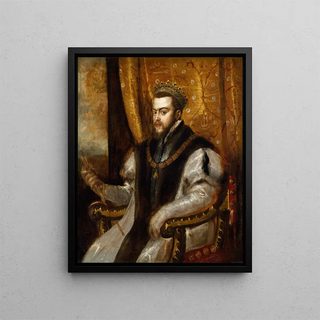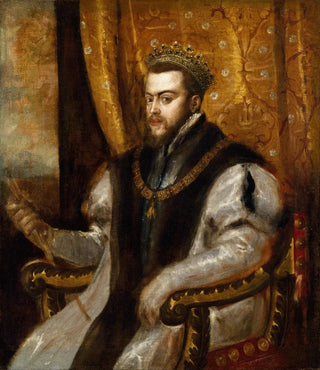Art print | King Philip II of Spain - Titian


View from behind

Frame (optional)
In the vibrant universe of the Renaissance, few works manage to capture the essence of a historical figure with as much power as the portrait of Philip II of Spain created by the Venetian master Titian. This iconic piece, which transcends mere royal representation, offers a fascinating glimpse into the complex personality of this king, both sovereign and man of culture. The art print of Le roi Philippe II d'Espagne - Titien allows appreciation of Titien's technical mastery while immersing oneself in the political and artistic atmosphere of his era. This painting is not limited to a simple image; it tells a story, that of a reign marked by imperial ambitions and spiritual struggles.
Style and uniqueness of the work
Titien's style is distinguished by his ability to combine realism and idealization, creating a depiction that is both faithful and elevated of his subjects. In the portrait of Philip II, the king is portrayed with a gravity that emphasizes his authority, but also with a palpable humanity that makes him accessible. The choice of colors, textures, and play of light demonstrates unparalleled mastery. The rich drapery of his robe, the contrast between the darkness of the background and the brightness of the face, as well as the meticulous details of the accessories, reveal a particular attention to the elements that compose the king's identity. This painting, through its balanced composition and psychological depth, invites the viewer to contemplate not only the royal figure but also the political and religious issues of his time. In sum, the work of Titien stands out for its ability to transcend the simple portrait to become a true reflection on power and humanity.
The artist and his influence
Titien, one of the greatest masters of Venetian painting, knew how to mark his era with an innovative approach to art. Trained in a context where color and light played a predominant role, he developed a style that combines harmony and expressiveness. His influence is undeniable, affecting not only his contemporaries but also generations of artists to come. Through his portraits, Titien was able to capture the soul of his

Matte finish

View from behind

Frame (optional)
In the vibrant universe of the Renaissance, few works manage to capture the essence of a historical figure with as much power as the portrait of Philip II of Spain created by the Venetian master Titian. This iconic piece, which transcends mere royal representation, offers a fascinating glimpse into the complex personality of this king, both sovereign and man of culture. The art print of Le roi Philippe II d'Espagne - Titien allows appreciation of Titien's technical mastery while immersing oneself in the political and artistic atmosphere of his era. This painting is not limited to a simple image; it tells a story, that of a reign marked by imperial ambitions and spiritual struggles.
Style and uniqueness of the work
Titien's style is distinguished by his ability to combine realism and idealization, creating a depiction that is both faithful and elevated of his subjects. In the portrait of Philip II, the king is portrayed with a gravity that emphasizes his authority, but also with a palpable humanity that makes him accessible. The choice of colors, textures, and play of light demonstrates unparalleled mastery. The rich drapery of his robe, the contrast between the darkness of the background and the brightness of the face, as well as the meticulous details of the accessories, reveal a particular attention to the elements that compose the king's identity. This painting, through its balanced composition and psychological depth, invites the viewer to contemplate not only the royal figure but also the political and religious issues of his time. In sum, the work of Titien stands out for its ability to transcend the simple portrait to become a true reflection on power and humanity.
The artist and his influence
Titien, one of the greatest masters of Venetian painting, knew how to mark his era with an innovative approach to art. Trained in a context where color and light played a predominant role, he developed a style that combines harmony and expressiveness. His influence is undeniable, affecting not only his contemporaries but also generations of artists to come. Through his portraits, Titien was able to capture the soul of his






